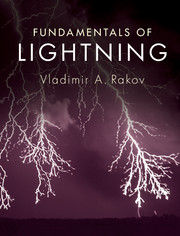Book contents
- Frontmatter
- Dedication
- Contents
- Preface
- 1 Types of lightning discharges and lightning terminology
- 2 Incidence of lightning to areas and structures
- 3 Electrical structure of thunderclouds
- 4 Properties of the downward negative lightning discharge to ground
- 5 Calculation of lightning electromagnetic fields
- 6 Modeling of the lightning return stroke
- 7 Measurement of lightning electric and magnetic fields
- 8 Electromagnetic methods of lightning location
- 9 Lightning damaging effects and protective techniques
- Appendices
- References
- Index
9 - Lightning damaging effects and protective techniques
Published online by Cambridge University Press: 05 April 2016
- Frontmatter
- Dedication
- Contents
- Preface
- 1 Types of lightning discharges and lightning terminology
- 2 Incidence of lightning to areas and structures
- 3 Electrical structure of thunderclouds
- 4 Properties of the downward negative lightning discharge to ground
- 5 Calculation of lightning electromagnetic fields
- 6 Modeling of the lightning return stroke
- 7 Measurement of lightning electric and magnetic fields
- 8 Electromagnetic methods of lightning location
- 9 Lightning damaging effects and protective techniques
- Appendices
- References
- Index
Summary
General principles
Systematic studies of thunderstorm electricity can be traced back to May 10, 1752 in the village of Marly-la-Ville, near Paris. On that day, in the presence of a nearby storm, a retired French dragoon, acting on instructions from Thomas-Francois Dalibard, drew sparks from a tall iron rod that was insulated from ground by wine bottles. The results of this experiment, proposed by Benjamin Franklin, provided the first direct proof that thunderclouds contain electricity. Even before the experiment at Marly, Franklin had proposed the use of grounded rods for lightning protection. Originally, he thought that the lightning rod would silently discharge a thundercloud and thereby would prevent the initiation of lightning. Later, Franklin stated that the lightning rod had a dual purpose: if it cannot prevent the occurrence of lightning, it offers a preferred attachment point for lightning and then a safe path for the lightning current to ground. It is in the latter manner that lightning rods, often referred to as Franklin rods, actually work.
There are generally two aspects of lightning protection design: (1) diversion and shielding, primarily intended for structural protection, but also serving to reduce the lightning electric and magnetic fields within the structure, and (2) the limiting of currents and voltages on electronic, power, and communication systems via surge protection. Primarily the first aspect will be considered in this chapter. Properly designed structural lightning protection systems for ground-based structures serve to provide lightning attachment points and paths for the lightning current to follow from the attachment points into the ground without harm to the protected structure. Such systems are basically composed of three elements: (1) “air terminals” at appropriate points on the structure to intercept the lightning, (2) “down conductors” to carry the lightning current from the air terminals toward the ground, and (3) “grounding electrodes” (ground terminals) to pass the lightning current into the earth. The three system components must be electrically well connected. The efficacy of this so-called conventional approach to lightning protection is evidenced by the comparative statistics of lightning damage to protected and unprotected structures. Neither data nor theory supports claims that non-conventional approaches, including “lightning elimination” and “early streamer emission” techniques, are superior to the conventional one (Uman and Rakov, 2002).
- Type
- Chapter
- Information
- Fundamentals of Lightning , pp. 178 - 192Publisher: Cambridge University PressPrint publication year: 2016



